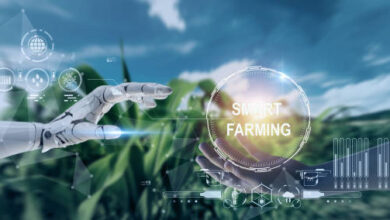
The agricultural sector is a vital part of the global economy, providing food and resources for billions of people around the world. However, this industry is not without its challenges. Economic agribusiness, the study of agricultural production, processing, and distribution, faces numerous obstacles such as fluctuating market prices, climate change, and technological advancements. These challenges require innovative solutions in order to ensure the sustainability and profitability of the agricultural sector. In this blog post, we will explore the various challenges facing economic agribusiness and the opportunities that arise from addressing them.
Understanding the Complex World of Economic Agribusiness
Economic agribusiness is a multifaceted field that involves understanding the economic principles and forces that shape the agricultural industry. It encompasses a wide range of topics, including supply and demand, production costs, market structures, and government policies. This complex world of agricultural economics requires a deep understanding of both the agricultural sector and the economic principles that govern it.
At its core, agricultural economics seeks to answer key questions such as: How do we allocate scarce resources efficiently in the production of food and other agricultural products? What are the factors that influence agricultural prices? How do government policies impact agricultural production and trade?
One of the main challenges in understanding agricultural economics is the inherent variability of the industry. Factors such as weather conditions, natural disasters, and pest infestations can greatly affect agricultural production and profitability. Additionally, global economic trends and market forces can lead to fluctuations in agricultural prices, making it difficult for farmers and agribusinesses to plan and make informed decisions.
Furthermore, the global nature of the agricultural industry adds another layer of complexity to agricultural economics. Agricultural markets are highly interconnected, with products and inputs being traded across borders. Understanding the impact of international trade policies and agreements is crucial for agricultural economists.
To navigate this complex world, agricultural economists utilize various tools and methodologies. They use statistical analysis to study historical data and trends, conduct economic modeling to analyze the impact of different factors on agricultural markets, and employ cost-benefit analysis to evaluate the economic viability of agricultural projects and policies.
Understanding the complex world of agricultural economics is essential for developing effective solutions to the challenges facing the agricultural industry. By analyzing the interactions between agriculture and economics, we can better comprehend the dynamics at play and make informed decisions to ensure the long-term sustainability and profitability of the sector.

Top Challenges Faced in Economics Agribusiness Today
In the ever-evolving field of economics agribusiness, there are several significant challenges that need to be addressed in order to ensure the sustainability and profitability of the agricultural sector. These challenges have a profound impact on the global economy and the lives of billions of people who depend on the agricultural industry for food and resources.
One of the major challenges faced in agricultural economics today is the fluctuating market prices. Agricultural products are subject to price volatility due to factors such as supply and demand imbalances, weather conditions, and global economic trends. These price fluctuations make it difficult for farmers and agribusinesses to plan their production and make informed decisions regarding their investments. It also creates uncertainty in the market, which can lead to market inefficiencies and inequities.
Another significant challenge is climate change. The agricultural industry is highly vulnerable to the adverse effects of climate change, such as extreme weather events, droughts, and changes in precipitation patterns. These climatic changes not only affect agricultural productivity but also impact the quality and availability of water resources, which are essential for agricultural activities. Additionally, climate change poses risks to the long-term viability of certain agricultural practices and systems, requiring innovative adaptation and mitigation strategies.
Technological advancements are also posing challenges to the agricultural industry. On one hand, technology has the potential to increase productivity, reduce production costs, and improve efficiency in the agricultural value chain. However, the adoption of new technologies also requires significant investments and may result in job displacement and increased income inequalities. The digital divide between rural and urban areas further exacerbates these challenges, as access to technology and digital literacy are often limited in rural communities.
Government policies and regulations can either support or hinder the agricultural sector. In many cases, policies and regulations are designed to address social and environmental concerns but may inadvertently impose additional costs and burdens on farmers and agribusinesses. Additionally, trade policies and agreements have a significant impact on agricultural markets, affecting prices, production, and trade flows. Navigating these complex policy environments requires a deep understanding of agricultural economics and effective advocacy for the interests of the agricultural sector.

Opportunities Hidden Within These Challenges and Economic Agribusiness
The challenges faced in economic agribusiness may seem daunting, but they also present unique opportunities for innovation and growth within the industry. By addressing these challenges head-on, we can create a more sustainable and prosperous agricultural sector.
One opportunity hidden within the challenge of fluctuating market prices is the potential for market diversification. Instead of relying solely on traditional agricultural products, farmers and agribusinesses can explore new markets and value-added products. This can help reduce the reliance on volatile commodity prices and create more stable income streams. For example, farmers can diversify their crops by growing specialty or organic produce, or they can explore niche markets such as farm-to-table restaurants or direct-to-consumer sales.
Climate change also presents opportunities for innovation in agricultural practices. By embracing climate-smart agriculture, farmers can adapt to changing weather patterns and reduce their carbon footprint. This can include implementing practices such as conservation agriculture, agroforestry, and precision farming. These practices not only help mitigate the effects of climate change but also increase productivity and resource efficiency.
Technological advancements, while posing challenges, also offer opportunities for increased productivity and efficiency in the agricultural value chain. From automated machinery to data analytics, technology can revolutionize the way we produce, process, and distribute agricultural products. Embracing digital tools and platforms can help farmers optimize their operations, reduce waste, and improve decision-making. Additionally, investing in research and development can lead to the discovery of new technologies that further enhance productivity and sustainability.

Innovative Solutions to Improve Economic Sustainability in Agriculture
In order to address the challenges facing the agricultural industry, innovative solutions are necessary to improve economic sustainability. These solutions can help ensure the long-term profitability and viability of the sector, while also promoting environmentally sustainable practices.
One innovative solution is the adoption of precision agriculture techniques. This involves the use of advanced technologies, such as drones, GPS, and sensors, to collect data on crop health, soil conditions, and weather patterns. By analyzing this data, farmers can make informed decisions regarding irrigation, fertilization, and pest control, thereby optimizing resource allocation and reducing waste. Precision agriculture not only increases productivity and efficiency but also reduces the environmental impact of farming practices.
Another solution is the implementation of sustainable farming practices. This includes the use of cover crops, crop rotation, and integrated pest management to maintain soil health, biodiversity, and water quality. Sustainable farming practices help reduce reliance on synthetic inputs, such as fertilizers and pesticides, which can be costly and harmful to the environment. By adopting these practices, farmers can improve soil fertility, conserve water resources, and reduce greenhouse gas emissions.
Investment in research and development is also crucial for improving economic sustainability in agriculture. By supporting innovation and technological advancements, policymakers and stakeholders can help farmers access new tools and practices that increase productivity and reduce production costs. Research and development can lead to the development of drought-resistant crops, disease-resistant livestock, and advanced machinery that streamline agricultural processes.
Lastly, promoting market diversification can contribute to economic sustainability in agriculture. Instead of relying on a single crop or commodity, farmers can explore new markets and value-added products. By diversifying their products and exploring niche markets, farmers can reduce their vulnerability to price fluctuations and create more stable income streams. This can involve growing specialty crops, producing organic products, or participating in direct-to-consumer sales.
By implementing these innovative solutions, we can improve economic sustainability in agriculture and ensure the long-term profitability of the sector. These solutions not only address the challenges facing the agricultural industry but also promote environmental sustainability and contribute to global food security.

Case Studies of Successful Application of Economic Agribusiness Solutions
In the world of economics agribusiness, it’s crucial to not only identify the challenges faced by the industry but also find effective solutions. Luckily, there are several inspiring case studies that demonstrate the successful application of agri-economics solutions.
One such case study comes from a group of farmers in a drought-prone region. They faced the challenge of decreasing water availability and increasing water costs, which significantly impacted their profitability. To address this issue, they collaborated with agricultural economists and researchers to implement precision irrigation techniques. By using sensors and data analytics, they were able to optimize their water usage, reduce wastage, and improve crop yields. This not only improved their economic sustainability but also contributed to the conservation of water resources.
Another case study highlights the success of a farmer who diversified his product line. Instead of solely relying on traditional crops, he ventured into the niche market of organic farming. Through research and analysis, he identified the high demand for organic produce and worked closely with agricultural economists to develop a business plan that would maximize his profits. By diversifying his products and tapping into this growing market, he was able to increase his income and reduce his vulnerability to price fluctuations.
In yet another case study, a cooperative of small-scale farmers faced the challenge of limited access to credit and market information. They partnered with an agricultural economist who helped them establish a farmer’s cooperative, which allowed them to pool their resources and access better market opportunities. Through this collaboration, they were able to negotiate better prices for their products and gain access to financial services that were previously out of reach. This not only improved their economic stability but also empowered the farmers as a collective unit.
These case studies highlight the importance of collaboration, innovation, and adaptability in the field of agricultural economics. By embracing new technologies, exploring niche markets, and finding creative solutions, we can overcome the challenges faced by the agricultural industry and ensure its long-term sustainability.

The Future of Economic Agribusiness: Embracing Changes for Prosperity
The future of economic agribusiness holds immense potential for growth and prosperity. As the agricultural industry continues to face various challenges, it is crucial for agribusinesses and policymakers to embrace changes and innovative solutions. By doing so, we can ensure the long-term sustainability and profitability of the agricultural sector.
One of the key changes that we need to embrace is the integration of technology in agricultural practices. From drones and sensors to data analytics and precision farming techniques, technology has the power to revolutionize the way we produce, process, and distribute agricultural products. By adopting these technologies, farmers can increase productivity, reduce production costs, and improve resource efficiency. This not only enhances the economic sustainability of the industry but also promotes environmental sustainability.
Additionally, it is essential to foster collaboration and knowledge-sharing within the agricultural community. By bringing together farmers, agribusinesses, researchers, and policymakers, we can create a platform for innovation and learning. Collaborative efforts can lead to the development of best practices, the sharing of market information, and the implementation of sustainable solutions. This will enable the agricultural sector to adapt to changing market dynamics and mitigate the impact of challenges such as price volatility and climate change.
Furthermore, there is a need for continued investment in research and development. By supporting scientific studies and advancements in agricultural practices, we can discover new solutions and technologies that improve productivity, resilience, and sustainability. Research and development can lead to the development of drought-resistant crops, disease-resistant livestock, and advanced machinery that streamline agricultural processes. By embracing these innovations, we can create a more prosperous and resilient agricultural industry.






3 Comments